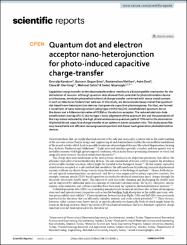Quantum dot and electron acceptor nano-heterojunction for photo-induced capacitive charge-transfer

Göster/
Erişim
info:eu-repo/semantics/openAccessTarih
2021Yazar
Karatum, OnuralpEren, Guncem Ozgun
Melikov, Rustamzhon
Onal, Asim
Ow-Yang, Cleva W.
Sahin, Mehmet
Üst veri
Tüm öğe kaydını gösterÖzet
Capacitive charge transfer at the electrode/electrolyte interface is a biocompatible mechanism for the stimulation of neurons. Although quantum dots showed their potential for photostimulation device architectures, dominant photoelectrochemical charge transfer combined with heavy-metal content in such architectures hinders their safe use. In this study, we demonstrate heavy-metal-free quantum dot-based nano-heterojunction devices that generate capacitive photoresponse. For that, we formed a novel form of nano-heterojunctions using type-II InP/ZnO/ZnS core/shell/shell quantum dot as the donor and a fullerene derivative of PCBM as the electron acceptor. The reduced electron-hole wavefunction overlap of 0.52 due to type-II band alignment of the quantum dot and the passivation of the trap states indicated by the high photoluminescence quantum yield of 70% led to the domination of photoinduced capacitive charge transfer at an optimum donor-acceptor ratio. This study paves the way toward safe and efficient nanoengineered quantum dot-based next-generation photostimulation devices.

















